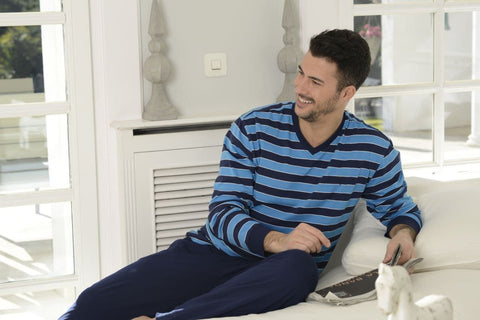How and why was there a transformation from wearing basic sleep tunics or underwear to specific fashionable sleepwear?
For most of Western history, life was very hard and people had very limited wardrobes. Most people wore a linen shirt (women) or a shirt (men) as their main undergarment, which often doubled as sleepwear. However, during the Renaissance, it began to be observed that the very wealthy started to have separate sleepwear, very similar to the shirt.
From the late Renaissance to the Baroque period, more relaxed garments were also incorporated into home clothing; today this type of clothing is known as loungewear. These garments included short jackets (which could be knitted) and a relaxed tunic worn by men called a banyan. Women adopted the dressing gown as a common item of use during the Baroque period. These lounge garments would be modified over the centuries (becoming robes, tuxedos, evening cloaks, etc.) but served the same purpose.
There was a much greater emphasis on proper clothing during the 19th century. Garments were much more affordable as a result of the industrial revolution (which also resulted in a shift from linen to cotton) and proper clothing was a way to establish status. It is believed that pajamas were introduced into Western clothing by British colonists who had adopted them while living in India. Nightgowns became increasingly associated with tradition, while pajamas were promoted as sensible, modern, and suitable for an active lifestyle. They became quite common after 1900.
Evolution of Pajamas According to Gender
Women began to adopt pajamas in the 1910s, when pan-orientalism was in vogue, and it reached its knit during the 1920s. Since then, men's pajamas have remained quite consistent, while women's pajamas have followed changes in fashion.
Women's nightgowns followed a similar trajectory during the 19th century. After the 1870s, nightgowns and the accompanying tunics became increasingly elaborate and tied to fashion trends. The materials became finer and more filmy, and color was introduced. Nightgowns would follow the fashion lines of clothing: examples from the 1920s are geometric and tubular, while those from the 1930s are sinuous and have bias cuts. Modern materials like rayon and nylon were widely used, making elaborate creations with ruffles more affordable and practical than ever.
Traditionally, women were expected to have a sleepwear wardrobe as an extension of their daily clothing. Women's sleepwear is more subject to the whims of fashion and, therefore, women buy more. In museum collections, women's nightgowns are abundant, while men's pajamas are hard to come by because men tend to wear the same thing over and over until it wears out.
Currently, it is not very common for the average man to be aware of the consequences of not frequently wearing sleepwear; to the knit of being able to conclude that this fact may have influenced the experience of long nights of poor sleep, even insomnia. It is also unlikely that once one tries the frequent use of pajamas as a "uniform for rest and relaxation," it is very possible that they will never give up using them.
Many people really do not consider the importance of sleepwear. If you think about it this way: just as you have work clothes for the professional environment and clothes that you would wear for a night out or a special gala, sleep time also demands a specific dress code. This intrinsically comes with many unexpected benefits included. One day, it will be noticed that by adhering to this code, the overnight stay in bed will be something more than comforting, and for very good reasons that will transcend in a palpable and definitive way in the overall well-being of the user.
Men's sleepwear ranges from pajamas to boxers, jackets, loose t-shirts, and relaxed pants. While style variations are amplified by design choices, emphasis is always placed on the comfort and sense of confidence that the garment provides to the wearer, which remains a constant consideration when choosing the right type of material and combination.
There is also a bit of history of sleepwear linked to men's clothing such as the pajama.
With so many people confined at home these last few months, due to the health emergency impacting the world in general, the interior of homes has become the new exterior for many. It is where exercise is done, where people chat digitally with friends, and of course, where remote work takes place. But it is still the interior, where one sleeps, rests, and carries out all the activities that are essential for the everyday life of the average human being. This can lead to frequent changes in clothing and, of course, a reevaluation of the male wardrobe.
The need for sleepwear, specifically pajamas as part of the male wardrobe, is more than just a piece of history attributed to necessity and modernity. It extends to that private comfort and allows for the development of a kind of relationship between the senses and different states of relaxation, leading to a true development of a healthy mental state for anyone. It is comfort at its finest, as the material of sleepwear, or the pajama is looser and does not cling to the body, providing a true state of freedom. This allows for sleeping without inhibitions and ensures that blood circulation remains optimal and that there are no obstructions while sleeping.
Although recently, the pajamas have become a style of outerwear and everyday wear for many people, it should be noted that the materials used to make these designs for different occasions and functions are also diverse. Therefore, sleepwear should not be confused with everyday and casual clothing. This everyday clothing, for being at home, could be a pair of shirts and worn-out pants, which are excessively used at home; which could be a variety of combinations and to which a relaxed and slow approach can be added to live life more leisurely.
One cannot underestimate the need for style in sleepwear; just as effort is put into selecting regular clothing, the pajamas should also be considered in these important decisions.

